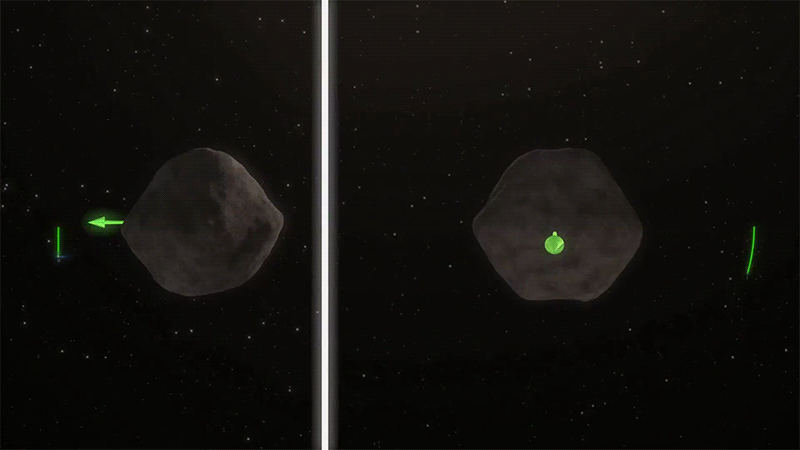Asteroid impact avoidance

Asteroid impact avoidance comprises the methods by which near-Earth objects (NEO) on a potential collision course with Earth could be diverted away, preventing destructive impact events. An impact by a sufficiently large asteroid or other NEOs would cause, depending on its impact location, massive tsunamis or multiple firestorms, and an impact winter caused by the sunlight-blocking effect of large quantities of pulverized rock dust and other debris placed into the stratosphere. A collision 66 million years ago between the Earth and an object approximately 10 kilometres (6 miles) wide is thought to have produced the Chicxulub crater and triggered the Cretaceous–Paleogene extinction event that is understood by the scientific community to have caused the extinction of all non-avian dinosaurs.
While the chances of a major collision are low in the near term, it is a near-certainty that one will happen eventually unless defensive measures are taken. Astronomical events—such as the Shoemaker-Levy 9 impacts on Jupiter and the 2013 Chelyabinsk meteor, along with the growing number of near-Earth objects discovered and catalogued on the Sentry Risk Table—have drawn renewed attention to such threats.[1] The popularity of the 2021 movie Don't Look Up helped to raise awareness of the possibility of avoiding NEOs.[2]
In 2016, a NASA scientist warned that the Earth is unprepared for such an event.[3] In April 2018, the B612 Foundation reported "It's 100 percent certain we'll be hit by a devastating asteroid, but we're not 100 percent sure when."[4] Also in 2018, physicist Stephen Hawking, in his final book, Brief Answers to the Big Questions, considered an asteroid collision to be the biggest threat to the planet.[5][6][7] Several ways of avoiding an asteroid impact have been described.[8] Nonetheless, in March 2019, scientists reported that asteroids may be much more difficult to destroy than thought earlier.[9][10] In addition, an asteroid may reassemble itself due to gravity after being disrupted.[11] In May 2021, NASA astronomers reported that 5 to 10 years of preparation may be needed to avoid a virtual impactor based on a simulated exercise conducted by the 2021 Planetary Defense Conference.[12][13][14]
Deflection efforts
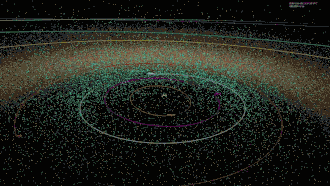
Video (0:55; July 23, 2018)
(Earth's orbit in white)
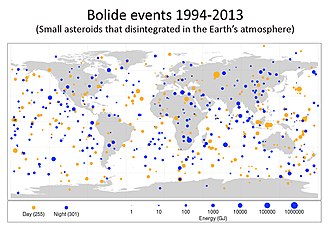
According to expert testimony in the United States Congress in 2013, NASA would require at least five years of preparation before a mission to intercept an asteroid could be launched.[15] In June 2018, the US National Science and Technology Council warned that the United States was unprepared for an asteroid impact event, and developed and released the "National Near-Earth Object Preparedness Strategy Action Plan" to better prepare.[16][17][18][19]
Most deflection efforts for a large object require from a year to decades of warning, allowing time to prepare and carry out a collision avoidance project, as no known planetary defense hardware has yet been developed. It has been estimated that a velocity change of just 3.5/t × 10−2 m·s−1 (where t is the number of years until potential impact) is needed to successfully deflect a body on a direct collision trajectory. In addition, under certain circumstances, much smaller velocity changes are needed.[20] For example, it was estimated there was a high chance of 99942 Apophis swinging by Earth in 2029 with a 10−4 probability of returning on an impact trajectory in 2035 or 2036. It was then determined that a deflection from this potential return trajectory, several years before the swing-by, could be achieved with a velocity change on the order of 10−6 m·s−1.[21]
NASA’s Double Asteroid Redirection Test (DART), the world’s first full-scale mission to test technology for defending Earth against potential asteroid or comet hazards, launched on a SpaceX Falcon 9 rocket from Space Launch Complex 4 East at Vandenberg Space Force Base in California.[22]
An impact by a 10 kilometres (6.2 mi) asteroid on the Earth has historically caused an extinction-level event due to catastrophic damage to the biosphere. There is also the threat from comets entering the inner Solar System. The impact speed of a long-period comet would likely be several times greater than that of a near-Earth asteroid, making its impact much more destructive; in addition, the warning time is unlikely to be more than a few months.[23] Impacts from objects as small as 50 metres (160 ft) in diameter, which are far more common, are historically extremely destructive regionally (see Barringer crater).
Finding out the material composition of the object is also helpful before deciding which strategy is appropriate. Missions like the 2005 Deep Impact probe and the Rosetta spacecraft, have provided valuable information on what to expect. In October 2022, a method of mapping the insides of a potentially problematic asteroid in order to determine the best area for impact was proposed.[24]
History of US government mandates
Efforts in asteroid impact prediction have concentrated on the survey method. The 1992 NASA-sponsored Near-Earth-Object Interception Workshop hosted by Los Alamos National Laboratory evaluated issues involved in intercepting celestial objects that could hit Earth.[25] In a 1992 report to NASA,[26] a coordinated Spaceguard Survey was recommended to discover, verify and provide follow-up observations for Earth-crossing asteroids. This survey was expected to discover 90% of these objects larger than one kilometer within 25 years. Three years later, another NASA report[27] recommended search surveys that would discover 60–70% of short-period, near-Earth objects larger than one kilometer within ten years and obtain 90% completeness within five more years.
In 1998, NASA formally embraced the goal of finding and cataloging, by 2008, 90% of all near-Earth objects (NEOs) with diameters of 1 km or larger that could represent a collision risk to Earth. The 1 km diameter metric was chosen after considerable study indicated that an impact of an object smaller than 1 km could cause significant local or regional damage but is unlikely to cause a worldwide catastrophe.[26] The impact of an object much larger than 1 km diameter could well result in worldwide damage up to, and potentially including, extinction of the human species. The NASA commitment has resulted in the funding of a number of NEO search efforts, which made considerable progress toward the 90% goal by 2008. However the 2009 discovery of several NEOs approximately 2 to 3 kilometers in diameter (e.g. 2009 CR2, 2009 HC82, 2009 KJ, 2009 MS and 2009 OG) demonstrated there were still large objects to be detected.
United States Representative George E. Brown Jr. (D-CA) was quoted as voicing his support for planetary defense projects in Air & Space Power Chronicles, saying "If some day in the future we discover well in advance that an asteroid that is big enough to cause a mass extinction is going to hit the Earth, and then we alter the course of that asteroid so that it does not hit us, it will be one of the most important accomplishments in all of human history."[28]
Because of Congressman Brown's long-standing commitment to planetary defense, a U.S. House of Representatives' bill, H.R. 1022, was named in his honor: The George E. Brown, Jr. Near-Earth Object Survey Act. This bill "to provide for a Near-Earth Object Survey program to detect, track, catalogue, and characterize certain near-Earth asteroids and comets" was introduced in March 2005 by Rep. Dana Rohrabacher (R-CA).[29] It was eventually rolled into S.1281, the NASA Authorization Act of 2005, passed by Congress on December 22, 2005, subsequently signed by the President, and stating in part:
The U.S. Congress has declared that the general welfare and security of the United States require that the unique competence of NASA be directed to detecting, tracking, cataloguing, and characterizing near-Earth asteroids and comets in order to provide warning and mitigation of the potential hazard of such near-Earth objects to the Earth. The NASA Administrator shall plan, develop, and implement a Near-Earth Object Survey program to detect, track, catalogue, and characterize the physical characteristics of near- Earth objects equal to or greater than 140 meters in diameter in order to assess the threat of such near-Earth objects to the Earth. It shall be the goal of the Survey program to achieve 90% completion of its near-Earth object catalogue (based on statistically predicted populations of near-Earth objects) within 15 years after the date of enactment of this Act. The NASA Administrator shall transmit to Congress not later than 1 year after the date of enactment of this Act an initial report that provides the following: (A) An analysis of possible alternatives that NASA may employ to carry out the Survey program, including ground-based and space-based alternatives with technical descriptions. (B) A recommended option and proposed budget to carry out the Survey program pursuant to the recommended option. (C) Analysis of possible alternatives that NASA could employ to divert an object on a likely collision course with Earth.
The result of this directive was a report presented to Congress in early March 2007. This was an Analysis of Alternatives (AoA) study led by NASA's Program Analysis and Evaluation (PA&E) office with support from outside consultants, the Aerospace Corporation, NASA Langley Research Center (LaRC), and SAIC (amongst others).
See also Improving impact prediction.
Ongoing projects
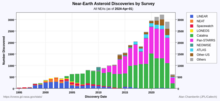
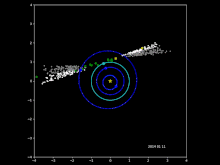
The Minor Planet Center in Cambridge, Massachusetts has been cataloging the orbits of asteroids and comets since 1947. It has recently been joined by surveys that specialize in locating the near-Earth objects (NEO), many (as of early 2007) funded by NASA's Near Earth Object program office as part of their Spaceguard program. One of the best-known is LINEAR that began in 1996. By 2004 LINEAR was discovering tens of thousands of objects each year and accounting for 65% of all new asteroid detections.[30] LINEAR uses two one-meter telescopes and one half-meter telescope based in New Mexico.[31]
The Catalina Sky Survey (CSS) is conducted at the Steward Observatory's Catalina Station, located near Tucson, Arizona, in the United States. It uses two telescopes, a 1.5-meter (60-inch) f/2 telescope on the peak of Mount Lemmon, and a 68-cm (27-inch) f/1.7 Schmidt telescope near Mount Bigelow (both in the Tucson, Arizona area). In 2005, CSS became the most prolific NEO survey surpassing Lincoln Near-Earth Asteroid Research (LINEAR) in total number of NEOs and potentially hazardous asteroids discovered each year since. CSS discovered 310 NEOs in 2005, 396 in 2006, 466 in 2007, and in 2008 564 NEOs were found.[32]
Spacewatch, which uses a 90 centimeter telescope sited at the Kitt Peak Observatory in Arizona, updated with automatic pointing, imaging, and analysis equipment to search the skies for intruders, was set up in 1980 by Tom Gehrels and Robert S. McMillan of the Lunar and Planetary Laboratory of the University of Arizona in Tucson, and is now being operated by McMillan. The Spacewatch project has acquired a 1.8 meter telescope, also at Kitt Peak, to hunt for NEOs, and has provided the old 90-centimeter telescope with an improved electronic imaging system with much greater resolution, improving its search capability.[33]
Other near-Earth object tracking programs include Near-Earth Asteroid Tracking (NEAT), Lowell Observatory Near-Earth-Object Search (LONEOS), Campo Imperatore Near-Earth Object Survey (CINEOS), Japanese Spaceguard Association, and Asiago-DLR Asteroid Survey.[34] Pan-STARRS completed telescope construction in 2010, and it is now actively observing.
The Asteroid Terrestrial-impact Last Alert System, now in operation, conducts frequent scans of the sky with a view to later-stage detection on the collision stretch of the asteroid orbit. Those would be much too late for deflection, but still in time for evacuation and preparation of the affected Earth region.
Another project, supported by the European Union, is NEOShield,[35] which analyses realistic options for preventing the collision of a NEO with Earth. Their aim is to provide test mission designs for feasible NEO mitigation concepts. The project particularly emphasises on two aspects.[35]
- The first one is the focus on technological development on essential techniques and instruments needed for guidance, navigation and control (GNC) in close vicinity of asteroids and comets. This will, for example, allow hitting such bodies with a high-velocity kinetic impactor spacecraft and observing them before, during and after a mitigation attempt, e.g., for orbit determination and monitoring.
- The second one focuses on refining Near Earth Object (NEO) characterisation. Moreover, NEOShield-2 will carry out astronomical observations of NEOs, to improve the understanding of their physical properties, concentrating on the smaller sizes of most concern for mitigation purposes, and to identify further objects suitable for missions for physical characterisation and NEO deflection demonstration.[36]
"Spaceguard" is the name for these loosely affiliated programs, some of which receive NASA funding to meet a U.S. Congressional requirement to detect 90% of near-Earth asteroids over 1 km diameter by 2008.[37] A 2003 NASA study of a follow-on program suggests spending US$250–450 million to detect 90% of all near-Earth asteroids 140 meters and larger by 2028.[38]
NEODyS is an online database of known NEOs.
Sentinel mission
The B612 Foundation is a private nonprofit foundation with headquarters in the United States, dedicated to protecting the Earth from asteroid strikes. It is led mainly by scientists, former astronauts and engineers from the Institute for Advanced Study, Southwest Research Institute, Stanford University, NASA and the space industry.
As a non-governmental organization it has conducted two lines of related research to help detect NEOs that could one day strike the Earth, and find the technological means to divert their path to avoid such collisions. The foundation's goal had been to design and build a privately financed asteroid-finding space telescope, Sentinel, which was to be launched in 2017–2018. However the project was cancelled in 2015. Had the Sentinel's infrared telescope been parked in an orbit similar to that of Venus, it would have helped identify threatening NEOs by cataloging 90% of those with diameters larger than 140 metres (460 ft), as well as surveying smaller Solar System objects.[39][40][41]
Data gathered by Sentinel would have helped identify asteroids and other NEOs that pose a risk of collision with Earth, by being forwarded to scientific data-sharing networks, including NASA and academic institutions such as the Minor Planet Center.[40][41][42] The foundation also proposes asteroid deflection of potentially dangerous NEOs by the use of gravity tractors to divert their trajectories away from Earth,[43][44] a concept co-invented by the organization's CEO, physicist and former NASA astronaut Ed Lu.[45]
Prospective projects
Orbit@home intends to provide distributed computing resources to optimize search strategy. On February 16, 2013, the project was halted due to lack of grant funding.[46] However, on July 23, 2013, the orbit@home project was selected for funding by NASA's Near Earth Object Observation program and was to resume operations sometime in early 2014.[47] As of July 13, 2018, the project is offline according to its website.[48]
The Large Synoptic Survey Telescope, currently under construction, is expected to perform a comprehensive, high-resolution survey starting in the early 2020s.
Detection from space
On November 8, 2007, the House Committee on Science and Technology's Subcommittee on Space and Aeronautics held a hearing to examine the status of NASA's Near-Earth Object survey program. The prospect of using the Wide-field Infrared Survey Explorer was proposed by NASA officials.[49]
WISE surveyed the sky in the infrared band at a very high sensitivity. Asteroids that absorb solar radiation can be observed through the infrared band. It was used to detect NEOs, in addition to performing its science goals. It is projected that WISE could detect 400 NEOs (roughly two percent of the estimated NEO population of interest) within the one-year mission.
NEOSSat, the Near Earth Object Surveillance Satellite, is a microsatellite launched in February 2013 by the Canadian Space Agency (CSA) that will hunt for NEOs in space.[50][51] Furthermore Near-Earth Object WISE (NEOWISE), an extension of the WISE mission, started in September 2013 (in its second mission extension) to hunt asteroids and comets close to the orbit of Earth.[52][53]
Deep Impact
Research published in the March 26, 2009 issue of the journal Nature, describes how scientists were able to identify an asteroid in space before it entered Earth's atmosphere, enabling computers to determine its area of origin in the Solar System as well as predict the arrival time and location on Earth of its shattered surviving parts. The four-meter-diameter asteroid, called 2008 TC3, was initially sighted by the automated Catalina Sky Survey telescope, on October 6, 2008. Computations correctly predicted that it would impact 19 hours after discovery and in the Nubian Desert of northern Sudan.[54]
A number of potential threats have been identified, such as 99942 Apophis (previously known by its provisional designation 2004 MN4), which in 2004 temporarily had an impact probability of about 3% for the year 2029. Additional observations revised this probability down to zero.[55]
Double Asteroid Redirection Test
On September 26, 2022 DART impacted Dimorphos, reducing the minor-planet moon's orbital period by 32 minutes. This mission was the first successful attempt at asteroid deflection.
Impact probability calculation pattern
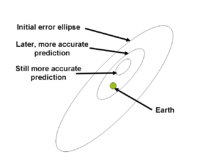
This section relies largely or entirely upon a single source. (December 2018) |
The ellipses in the diagram on the right show the predicted position of an example asteroid at closest Earth approach. At first, with only a few asteroid observations, the error ellipse is very large and includes the Earth. Further observations shrink the error ellipse, but it still includes the Earth. This raises the predicted impact probability, since the Earth now covers a larger fraction of the error region. Finally, yet more observations (often radar observations, or discovery of a previous sighting of the same asteroid on archival images) shrink the ellipse revealing that the Earth is outside the error region, and the impact probability is near zero.[56]
For asteroids that are actually on track to hit Earth the predicted probability of impact continues to increase as more observations are made. This similar pattern makes it difficult to differentiate between asteroids that will only come close to Earth and those that will actually hit it. This in turn makes it difficult to decide when to raise an alarm as gaining more certainty takes time, which reduces time available to react to a predicted impact. However, raising the alarm too soon has the danger of causing a false alarm and creating a Boy Who Cried Wolf effect if the asteroid in fact misses Earth.
Collision avoidance strategies
Various collision avoidance techniques have different trade-offs with respect to metrics such as overall performance, cost, failure risks, operations, and technology readiness.[57] There are various methods for changing the course of an asteroid/comet.[58] These can be differentiated by various types of attributes such as the type of mitigation (deflection or fragmentation), energy source (kinetic, electromagnetic, gravitational, solar/thermal, or nuclear), and approach strategy (interception,[59][60] rendezvous, or remote station).
Strategies fall into two basic sets: Fragmentation and delay.[58][61] Fragmentation concentrates on rendering the impactor harmless by fragmenting it and scattering the fragments so that they miss the Earth or are small enough to burn up in the atmosphere. Delay exploits the fact that both the Earth and the impactor are in orbit. An impact occurs when both reach the same point in space at the same time, or more correctly when some point on Earth's surface intersects the impactor's orbit when the impactor arrives. Since the Earth is approximately 12,750 km in diameter and moves at approx. 30 km per second in its orbit, it travels a distance of one planetary diameter in about 425 seconds, or slightly over seven minutes. Delaying, or advancing the impactor's arrival by times of this magnitude can, depending on the exact geometry of the impact, cause it to miss the Earth.[62]
Collision avoidance strategies can also be seen as either direct, or indirect and in how rapidly they transfer energy to the object. The direct methods, such as nuclear explosives, or kinetic impactors, rapidly intercept the bolide's path. Direct methods are preferred because they are generally less costly in time and money.[citation needed] Their effects may be immediate, thus saving precious time. These methods would work for short-notice and long-notice threats, and are most effective against solid objects that can be directly pushed, but in the case of kinetic impactors, they are not very effective against large loosely aggregated rubble piles. Indirect methods, such as gravity tractors, attaching rockets or mass drivers, are much slower. They require traveling to the object, changing course up to 180 degrees for space rendezvous, and then taking much more time to change the asteroid's path just enough so it will miss Earth.[citation needed]
Many NEOs are thought to be "flying rubble piles" only loosely held together by gravity, and a typical spacecraft sized kinetic-impactor deflection attempt might just break up the object or fragment it without sufficiently adjusting its course.[63] If an asteroid breaks into fragments, any fragment larger than 35 meters across would not burn up in the atmosphere and itself could impact Earth. Tracking the thousands of buckshot-like fragments that could result from such an explosion would be a very daunting task, although fragmentation would be preferable to doing nothing and allowing the originally larger rubble body, which is analogous to a shot and wax slug, to impact the Earth.[citation needed]
In Cielo simulations conducted in 2011–2012, in which the rate and quantity of energy delivery were sufficiently high and matched to the size of the rubble pile, such as following a tailored nuclear explosion, results indicated that any asteroid fragments, created after the pulse of energy is delivered, would not pose a threat of re-coalescing (including for those with the shape of asteroid Itokawa) but instead would rapidly achieve escape velocity from their parent body (which for Itokawa is about 0.2 m/s) and therefore move out of an earth-impact trajectory.[64][65][66]
Nuclear explosive device
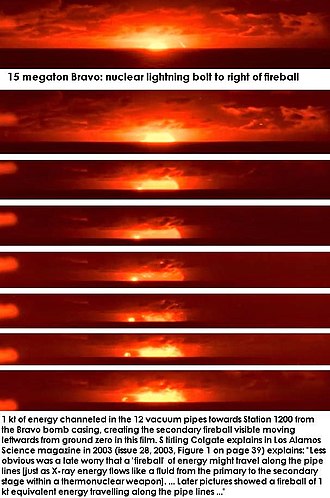
Initiating a nuclear explosive device above, on, or slightly beneath, the surface of a threatening celestial body is a potential deflection option, with the optimal detonation height dependent upon the composition and size of the object.[71][72][73] It does not require the entire NEO to be vaporized to mitigate an impact threat. In the case of an inbound threat from a "rubble pile," the stand off, or detonation height above the surface configuration, has been put forth as a means to prevent the potential fracturing of the rubble pile.[74] The energetic neutrons and soft X-rays released by the detonation, which do not appreciably penetrate matter,[75] are converted into heat upon encountering the object's surface matter, ablatively vaporizing all line of sight exposed surface areas of the object to a shallow depth,[74] turning the surface material it heats up into ejecta, and, analogous to the ejecta from a chemical rocket engine exhaust, changing the velocity, or "nudging", the object off course by the reaction, following Newton's third law, with ejecta going one way and the object being propelled in the other.[74][76] Depending on the energy of the explosive device, the resulting rocket exhaust effect, created by the high velocity of the asteroid's vaporized mass ejecta, coupled with the object's small reduction in mass, would produce enough of a change in the object's orbit to make it miss the Earth.[64][76]
A Hypervelocity Asteroid Mitigation Mission for Emergency Response (HAMMER) has been proposed.[77]
Stand-off approach
If the object is very large but is still a loosely-held-together rubble pile, a solution is to detonate one or a series of nuclear explosive devices alongside the asteroid, at a 20-meter (66 ft) or greater stand-off height above its surface,[citation needed] so as not to fracture the potentially loosely-held-together object. Providing that this stand-off strategy was done far enough in advance, the force from a sufficient number of nuclear blasts would alter the object's trajectory enough to avoid an impact, according to computer simulations and experimental evidence from meteorites exposed to the thermal X-ray pulses of the Z-machine.[78]
In 1967, graduate students under Professor Paul Sandorff at the Massachusetts Institute of Technology were tasked with designing a method to prevent a hypothetical 18-month distant impact on Earth by the 1.4-kilometer-wide (0.87 mi) asteroid 1566 Icarus, an object that makes regular close approaches to Earth, sometimes as close as 16 lunar distances.[79] To achieve the task within the timeframe and with limited material knowledge of the asteroid's composition, a variable stand-off system was conceived. This would have used a number of modified Saturn V rockets sent on interception courses and the creation of a handful of nuclear explosive devices in the 100-megaton energy range—coincidentally, the same as the maximum yield of the Soviets' Tsar Bomba would have been if a uranium tamper had been used—as each rocket vehicle's payload.[80][81] The design study was later published as Project Icarus[82] which served as the inspiration for the 1979 film Meteor.[81][83][84]
A NASA analysis of deflection alternatives, conducted in 2007, stated:
Nuclear standoff explosions are assessed to be 10–100 times more effective than the non-nuclear alternatives analyzed in this study. Other techniques involving the surface or subsurface use of nuclear explosives may be more efficient, but they run an increased risk of fracturing the target NEO. They also carry higher development and operations risks.[85]
In the same year, NASA released a study where the asteroid Apophis (with a diameter of around 300 metres or 1,000 feet) was assumed to have a much lower rubble pile density (1,500 kg/m3 or 100 lb/cu ft) and therefore lower mass than it is now known to have, and in the study, it is assumed to be on an impact trajectory with Earth for the year 2029. Under these hypothetical conditions, the report determines that a "Cradle spacecraft" would be sufficient to deflect it from Earth impact. This conceptual spacecraft contains six B83 physics packages, each set for their maximum 1.2-megatonne yield,[76] bundled together and lofted by an Ares V vehicle sometime in the 2020s, with each B83 being fuzed to detonate over the asteroid's surface at a height of 100 metres or 330 feet ("1/3 of the objects diameter" as its stand-off), one after the other, with hour-long intervals between each detonation. The results of this study indicated that a single employment of this option "can deflect NEOs of [100–500 metres or 330–1,640 feet diameter] two years before impact, and larger NEOs with at least five years warning".[76][86] These effectiveness figures are considered to be "conservative" by its authors, and only the thermal X-ray output of the B83 devices was considered, while neutron heating was neglected for ease of calculation purposes.[86][87]
Surface and subsurface use
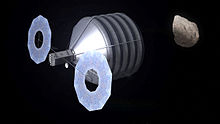
In 2011, the director of the Asteroid Deflection Research Center at Iowa State University, Dr. Bong Wie (who had published kinetic impactor deflection studies[63] previously), began to study strategies that could deal with 50-to-500-metre-diameter (200–1,600 ft) objects when the time to Earth impact was less than one year. He concluded that to provide the required energy, a nuclear explosion or other event that could deliver the same power, are the only methods that can work against a very large asteroid within these time constraints.
This work resulted in the creation of a conceptual Hypervelocity Asteroid Intercept Vehicle (HAIV), which combines a kinetic impactor to create an initial crater for a follow-up subsurface nuclear detonation within that initial crater, which would generate a high degree of efficiency in the conversion of the nuclear energy that is released in the detonation into propulsion energy to the asteroid.[89]
A similar proposal would use a surface-detonating nuclear device in place of the kinetic impactor to create the initial crater, then using the crater as a rocket nozzle to channel succeeding nuclear detonations.
At the 2014 NASA Innovative Advanced Concepts (NIAC) conference, Wie and his colleagues stated that "we have the solution, using our baseline concept, to be able to mitigate the asteroid-impact threat, with any range of warning." For example, according to their computer models, with a warning time of 30 days, a 300-metre-wide (1,000 ft) asteroid would be neutralized[vague] by using a single HAIV, with less than 0.1% of the destroyed object's mass potentially striking Earth, which by comparison would be more than acceptable.[further explanation needed][90][91]
As of 2015, Wie has collaborated with the Danish Emergency Asteroid Defence Project (EADP),[92] which ultimately intends to crowdsource sufficient funds to design, build, and store a non-nuclear HAIV spacecraft as planetary insurance. For threatening asteroids too large and/or too close to Earth impact to effectively be deflected by the non-nuclear HAIV approach, nuclear explosive devices (with 5% of the explosive yield than those used for the stand-off strategy) are intended to be swapped in, under international oversight, when conditions arise that necessitate it.[93]
Comet deflection possibility
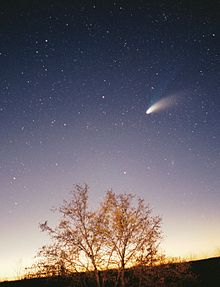
— Lord Byron[94]
Following the 1994 Shoemaker-Levy 9 comet impacts with Jupiter, Edward Teller proposed, to a collective of U.S. and Russian ex-Cold War weapons designers in a 1995 planetary defense workshop meeting at Lawrence Livermore National Laboratory (LLNL), that they collaborate to design a one-gigaton nuclear explosive device, which would be equivalent to the kinetic energy of a one-kilometer-diameter (0.62 mi) asteroid.[95][96][97] The theoretical one-gigaton device would weigh about 25–30 tons, light enough to be lifted on the Energia rocket. It could be used to instantaneously vaporize a one-kilometre (0.62 mi) asteroid, divert the paths of ELE-class asteroids (greater than 10 kilometres or 6.2 miles in diameter) within short notice of a few months. With one year of notice, and at an interception location no closer than Jupiter, it could also deal with the even rarer short period comets that can come out of the Kuiper belt and transit past Earth orbit within two years.[clarification needed] For comets of this class, with a maximum estimated diameter of 100 kilometers (62 mi), Chiron served as the hypothetical threat.[95][96][97]
In 2013, the related National Laboratories of the US and Russia signed a deal that includes an intent to cooperate on defense from asteroids.[98]
Present capability
An April 2014 GAO report notes that the NNSA is retaining canned subassemblies (CSAs—nuclear secondary stages) in an indeterminate state pending a senior-level government evaluation of their use in planetary defense against earthbound asteroids."[99] In its FY2015 budget request, the NNSA noted that the nine-megaton B53 component disassembly was "delayed", leading some observers to conclude they might be the warhead CSAs being retained for potential planetary defense purposes.[100][failed verification]
Kinetic impact
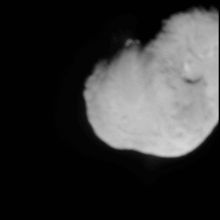
The impact of a massive object, such as a spacecraft or even another near-Earth object, is another possible solution to a pending NEO impact. An object with a high mass close to the Earth could be sent out into a collision course with the asteroid, knocking it off course.
When the asteroid is still far from the Earth, a means of deflecting the asteroid is to directly alter its momentum by colliding a spacecraft with the asteroid.
A NASA analysis of deflection alternatives, conducted in 2007, stated:
Non-nuclear kinetic impactors are the most mature approach and could be used in some deflection/mitigation scenarios, especially for NEOs that consist of a single small, solid body.[85]
This deviation method, which has been implemented by DART and, for a completely different purpose (analysis of the structure and composition of a comet), by NASA's Deep Impact space probe, involves launching a spacecraft against the near Earth object. The speed of the asteroid is modified due to the law of conservation of momentum:
with V1 velocity of the spacecraft, V2 velocity of the celestial body before impact, and V3 the velocity after impact. M1 and M2 respective mass of the spacecraft and of the celestial body. Velocities are vectors here.
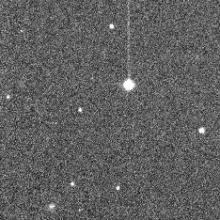
The European Union's NEOShield-2 Mission[104] is also primarily studying the Kinetic Impactor mitigation method. The principle of the kinetic impactor mitigation method is that the NEO or Asteroid is deflected following an impact from an impactor spacecraft. The principle of momentum transfer is used, as the impactor crashes into the NEO at a very high velocity of 10 km/s (36,000 km/h; 22,000 mph) or more. The momentum of the impactor is transferred to the NEO, causing a change in velocity and therefore making it deviate from its course slightly.[105]
As of mid-2021, the modified AIDA mission has been approved. The NASA Double Asteroid Redirection Test (DART) kinetic impactor spacecraft was launched in November 2021. The goal was to impact Dimorphos (nicknamed Didymoon), the 180-meter (590 ft) minor-planet moon of near-Earth asteroid 65803 Didymos. The impact occurred in September 2022 when Didymos is relatively close to Earth, allowing Earth-based telescopes and planetary radar to observe the event. The result of the impact will be to change the orbital velocity and hence orbital period of Dimorphos, by a large enough amount that it can be measured from Earth. This will show for the first time that it is possible to change the orbit of a small 200-meter (660 ft) asteroid, around the size most likely to require active mitigation in the future. The second part of the AIDA mission–the ESA HERA spacecraft–has been approved by ESA member states in October 2019. It would reach the Didymos system in 2026 and measure both the mass of Dimorphos and the precise effect of the impact on that body, allowing much better extrapolation of the AIDA mission to other targets.[106]
Asteroid gravity tractor
Another alternative to explosive deflection is to move the asteroid slowly over time. A small but constant amount of thrust accumulates to deviate an object sufficiently from its course. Edward T. Lu and Stanley G. Love have proposed using a massive unmanned spacecraft hovering over an asteroid to gravitationally pull the asteroid into a non-threatening orbit. Though both objects are gravitationally pulled towards each other, the spacecraft can counter the force towards the asteroid by, for example, an ion thruster, so the net effect would be that the asteroid is accelerated towards the spacecraft and thus slightly deflected from its orbit. While slow, this method has the advantage of working irrespective of the asteroid's composition or spin rate; rubble pile asteroids would be difficult to deflect by means of nuclear detonations, while a pushing device would be difficult or inefficient to mount on a fast-rotating asteroid. A gravity tractor would likely have to spend several years beside the asteroid to be effective.
A NASA analysis of deflection alternatives, conducted in 2007, stated:
"Slow push" mitigation techniques are the most expensive, have the lowest level of technical readiness, and their ability to both travel to and divert a threatening NEO would be limited unless mission durations of many years to decades are possible.[85]
Ion beam shepherd
Another "contactless" asteroid deflection technique has been proposed by C. Bombardelli and J. Peláez from the Technical University of Madrid. The method involves the use of a low-divergence ion thruster pointed at the asteroid from a nearby hovering spacecraft. The momentum transmitted by the ions reaching the asteroid surface produces a slow but continuous force that can deflect the asteroid in a similar way as the gravity tractor, but with a lighter spacecraft.
Focused solar energy
H. J. Melosh with I. V. Nemchinov proposed deflecting an asteroid or comet by focusing solar energy onto its surface to create thrust from the resulting vaporization of material.[107] This method would first require the construction of a space station with a system of large collecting, concave mirrors similar to those used in solar furnaces.
Orbit mitigation with highly concentrated sunlight is scalable to achieving the predetermined deflection within a year even for a global-threatening body without prolonged warning time.[107][108]
Such a hastened strategy may become topical in the case of late detection of a potential hazard, and also, if required, in providing the possibility for some additional action. Conventional concave reflectors are practically inapplicable to the high-concentrating geometry in the case of a giant shadowing space target, which is located in front of the mirrored surface. This is primarily because of the dramatic spread of the mirrors' focal points on the target due to the optical aberration when the optical axis is not aligned with the Sun. On the other hand, the positioning of any collector at a distance to the target much larger than its size does not yield the required concentration level (and therefore temperature) due to the natural divergence of the sunrays. Such principal restrictions are inevitably at any location regarding the asteroid of one or many unshaded forward-reflecting collectors. Also, in the case of secondary mirrors use, similar to the ones found in Cassegrain telescopes, would be prone to heat damage by partially concentrated sunlight from primary mirror.
In order to remove the above restrictions, V.P. Vasylyev proposed to apply an alternative design of a mirrored collector – the ring-array concentrator.[108] This type of collector has an underside lens-like position of its focal area that avoids shadowing of the collector by the target and minimizes the risk of its coating by ejected debris. Provided the sunlight concentration ~ 5 × 103 times, a surface irradiance of around 4-5 MW/m2 leads to a thrusting effect ~ 103 N. Intensive ablation of the rotating asteroid surface under the focal spot will lead to the appearance of a deep "canyon", which can contribute to the formation of the escaping gas flow into a jet-like one. This may be sufficient to deflect a 0.5-km asteroid within several months and no addition warning period, only using ring-array collector size ~ 0.5 of asteroid diameter. For such a prompt deflection of the larger NEOs, 1.3-2.2 km, the required collector sizes are comparable to the target diameter. In the case of a longer warning time, the required size of the collector may be significantly decreased.

Mass driver
A mass driver is an (automated) system on the asteroid to eject material into space, thus giving the object a slow steady push and decreasing its mass. A mass driver is designed to work as a very low specific impulse system, which in general uses a lot of propellant, but very little power.
The idea is that when using local material as propellant, the amount of propellant is not as important as the amount of power, which is likely to be limited.
Conventional rocket engine
Attaching any spacecraft propulsion device would have a similar effect of giving a push, possibly forcing the asteroid onto a trajectory that takes it away from Earth. An in-space rocket engine that is capable of imparting an impulse of 106 N·s (E.g. adding 1 km/s to a 1000 kg vehicle), will have a relatively small effect on a relatively small asteroid that has a mass of roughly a million times more. Chapman, Durda, and Gold's white paper[109] calculates deflections using existing chemical rockets delivered to the asteroid.
Such direct force rocket engines are typically proposed to use highly-efficient electrically powered spacecraft propulsion, such as ion thrusters or VASIMR.
Asteroid laser ablation
Similar to the effects of a nuclear device, it is thought possible to focus sufficient laser energy on the surface of an asteroid to cause flash vaporization / ablation to create either in impulse or to ablate away the asteroid mass. This concept, called asteroid laser ablation was articulated in the 1995 SpaceCast 2020[110] white paper "Preparing for Planetary Defense",[111] and the 1996 Air Force 2025[112] white paper "Planetary Defense: Catastrophic Health Insurance for Planet Earth".[113] Early publications include C. R. Phipps "ORION" concept from 1996, Colonel Jonathan W. Campbell's 2000 monograph "Using Lasers in Space: Laser Orbital Debris Removal and Asteroid Deflection",[114] and NASA's 2005 concept Comet Asteroid Protection System (CAPS).[115] Typically such systems require a significant amount of power, such as would be available from a Space-Based Solar Power Satellite.
Another proposal is the Phillip Lubin's DE-STAR[116] proposal:
- The DE-STAR project,[117] proposed by researchers at the University of California, Santa Barbara, is a concept modular solar powered 1 µm, near infrared wavelength, laser array. The design calls for the array to eventually be approximately 1 km squared in size, with the modular design meaning that it could be launched in increments and assembled in space. In its early stages as a small array it could deal with smaller targets, assist solar sail probes and would also be useful in cleaning up space debris.
Other proposals
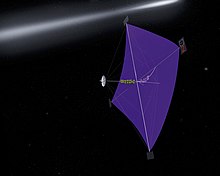
- Wrapping the asteroid in a sheet of reflective plastic such as aluminized PET film as a solar sail
- "Painting" or dusting the object with titanium dioxide (white) to alter its trajectory via increased reflected radiation pressure or with soot (black) to alter its trajectory via the Yarkovsky effect.
- Planetary scientist Eugene Shoemaker in 1996 proposed[118] deflecting a potential impactor by releasing a cloud of steam in the path of the object, hopefully gently slowing it. Nick Szabo in 1990 sketched[119] a similar idea, "cometary aerobraking", the targeting of a comet or ice construct at an asteroid, then vaporizing the ice with nuclear explosives to form a temporary atmosphere in the path of the asteroid.
- Coherent digger array[120][121] multiple 1-ton flat tractors able to dig and expel asteroid soil mass as a coherent fountain array, coordinated fountain activity may propel and deflect over years.
- Attaching a tether and ballast mass to the asteroid to alter its trajectory by changing its center of mass.[122]
- Magnetic flux compression to magnetically brake and or capture objects that contain a high percentage of meteoric iron by deploying a wide coil of wire in its orbital path and when it passes through, Inductance creates an electromagnet solenoid to be generated.[123][124]
Deflection technology concerns
Carl Sagan, in his book Pale Blue Dot, expressed concern about deflection technology, noting that any method capable of deflecting impactors away from Earth could also be abused to divert non-threatening bodies toward the planet. Considering the history of genocidal political leaders and the possibility of the bureaucratic obscuring of any such project's true goals to most of its scientific participants, he judged the Earth at greater risk from a man-made impact than a natural one. Sagan instead suggested that deflection technology be developed only in an actual emergency situation.
All low-energy delivery deflection technologies have inherent fine control and steering capability, making it possible to add just the right amount of energy to steer an asteroid originally destined for a mere close approach toward a specific Earth target.
According to former NASA astronaut Rusty Schweickart, the gravitational tractor method is controversial because, during the process of changing an asteroid's trajectory, the point on the Earth where it could most likely hit would be slowly shifted across different countries. Thus, the threat for the entire planet would be minimized at the cost of some specific states' security. In Schweickart's opinion, choosing the way the asteroid should be "dragged" would be a tough diplomatic decision.[125]
Analysis of the uncertainty involved in nuclear deflection shows that the ability to protect the planet does not imply the ability to target the planet. A nuclear explosion that changes an asteroid's velocity by 10 meters/second (plus or minus 20%) would be adequate to push it out of an Earth-impacting orbit. However, if the uncertainty of the velocity change was more than a few percent, there would be no chance of directing the asteroid to a particular target.
Planetary defense timeline
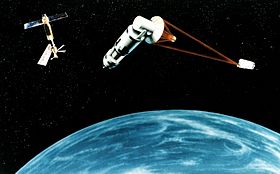
- In their 1964 book, Islands in Space, Dandridge M. Cole and Donald W. Cox noted the dangers of planetoid impacts, both those occurring naturally and those that might be brought about with hostile intent. They argued for cataloging the minor planets and developing the technologies to land on, deflect, or even capture planetoids.[127]
- In 1967, students in the Aeronautics and Astronautics department at MIT did a design study, "Project Icarus", of a mission to prevent a hypothetical impact on Earth by asteroid 1566 Icarus.[81] The design project was later published in a book by the MIT Press[82] and received considerable publicity, for the first time bringing asteroid impact into the public eye.[80]
- In the 1980s NASA studied evidence of past strikes on planet Earth, and the risk of this happening at the current level of civilization. This led to a program that maps objects in the Solar System that both cross Earth's orbit and are large enough to cause serious damage if they hit.
- In the 1990s, US Congress held hearings to consider the risks and what needed to be done about them. This led to a US$3 million annual budget for programs like Spaceguard and the near-Earth object program, as managed by NASA and USAF.
- In 2005 a number of astronauts published an open letter through the Association of Space Explorers calling for a united push to develop strategies to protect Earth from the risk of a cosmic collision.[128]
- It is currently (as of late 2007) estimated that there are approximately 20,000 objects capable of crossing Earth's orbit and large enough (140 meters or larger) to warrant concern.[129] On the average, one of these will collide with Earth every 5,000 years, unless preventive measures are undertaken.[130] It was anticipated that by year 2008, 90% of such objects that are 1 km or more in diameter will have been identified and will be monitored. The further task of identifying and monitoring all such objects of 140m or greater was expected to be complete around 2020.[130] By April 2018, astronomers have spotted more than 8,000 near-Earth asteroids that are at least 460 feet (140 meters) wide and it is estimated about 17,000 such near-Earth asteroids remain undetected.[131] By 2019, the number of discovered near-Earth asteroids of all sizes totaled more than 19,000. An average of 30 new discoveries are added each week.[132]
- The Catalina Sky Survey[133] (CSS) is one of NASA's four funded surveys to carry out a 1998 U.S. Congress mandate to find and catalog by the end of 2008, at least 90 percent of all near-Earth objects (NEOs) larger than 1 kilometer across. CSS discovered over 1150 NEOs in years 2005 to 2007. In doing this survey they discovered on November 20, 2007, an asteroid, designated 2007 WD5, which initially was estimated to have a chance of hitting Mars on January 30, 2008, but further observations during the following weeks allowed NASA to rule out an impact.[134] NASA estimated a near miss by 26,000 kilometres (16,000 mi).[135]
- In January 2012, after a near pass-by of object 2012 BX34, a paper entitled "A Global Approach to Near-Earth Object Impact Threat Mitigation" was released by researchers from Russia, Germany, the United States, France, Britain, and Spain, which discusses the "NEOShield" project.[136]
- In January 2022, The NASA-funded Asteroid Terrestrial-impact Last Alert System (ATLAS)—a state-of-the-art asteroid detection system operated by the University of Hawaiʻi (UH) Institute for Astronomy (IfA) for the agency’s Planetary Defense Coordination Office (PDCO)—has reached a new milestone by becoming the first survey capable of searching the entire dark sky every 24 hours for near-Earth objects (NEOs) that could pose a future impact hazard to Earth. Now comprising four telescopes, ATLAS has expanded its reach to the southern hemisphere from the two existing northern-hemisphere telescopes on Haleakalā and Maunaloa in Hawai’i to include two additional observatories in South Africa and Chile. [137]
See also
- Asteroid impact prediction
- Asteroid Redirect Mission
- Asteroid Day
- Asteroids in fiction
- B612 Foundation
- Colonization of the Moon
- Framework Programmes for Research and Technological Development
- Global catastrophic risk
- Gravity tractor
- Lost minor planet
- Near-Earth Asteroid Scout
- Near-Earth object
- Potentially hazardous object
- United States Space Force[138]
Sources
![]() This article incorporates public domain material from Linda Herridge. NASA, SpaceX Launch DART: First Planetary Defense Test Mission. National Aeronautics and Space Administration. Retrieved 24 August 2022.
This article incorporates public domain material from Linda Herridge. NASA, SpaceX Launch DART: First Planetary Defense Test Mission. National Aeronautics and Space Administration. Retrieved 24 August 2022.
References
Citations
- ^ Rahman, Shoaib (2021-04-10). "How Much Our Earth Is Ready To Prevent Future Asteroid Collisions?". Futurism. Archived from the original on 2021-09-12. Retrieved 2021-11-17.
- ^ Powell, Corey S. (December 20, 2021). "How prepared is Earth for an asteroid collision?". Astronomy. Archived from the original on 2021-12-20. Retrieved 2022-01-12.
- ^ Yuhas, Alan (13 December 2016). "Earth woefully unprepared for surprise comet or asteroid, Nasa scientist warns". The Guardian.
- ^ Homer, Aaron (28 April 2018). "Earth Will Be Hit By An Asteroid With 100 Percent Certainty, Says Space-Watching Group B612". Inquisitr. Retrieved 28 April 2018.
- ^ Stanley-Becker, Isaac (15 October 2018). "Stephen Hawking feared race of 'superhumans' able to manipulate their own DNA". The Washington Post. Retrieved 15 October 2018.
- ^ Haldevang, Max de (14 October 2018). "Stephen Hawking left us bold predictions on AI, superhumans, and aliens". Quartz. Retrieved 15 October 2018.
- ^ Bogdan, Dennis (18 June 2018). "Better Way To Avoid Devastating Asteroids Needed?". The New York Times. Retrieved 19 November 2018.
- ^ Wall, Mike (2 May 2019). "A Killer Asteroid Is Coming — We Don't Know When (So Let's Be Ready), Bill Nye Says". Space.com. Retrieved 2 May 2019.
- ^ Johns Hopkins University (4 March 2019). "Asteroids are stronger, harder to destroy than previously thought". Phys.org. Retrieved 4 March 2019.
- ^ El Mir, Charles; Ramesh, KT; Richardson, Derek C. (15 March 2019). "A new hybrid framework for simulating hypervelocity asteroid impacts and gravitational reaccumulation". Icarus. 321: 1013–1025. Bibcode:2019Icar..321.1013E. doi:10.1016/j.icarus.2018.12.032. S2CID 127119234.
- ^ Andrews, Robin George (8 March 2019). "If We Blow Up an Asteroid, It Might Put Itself Back Together – Despite what Hollywood tells us, stopping an asteroid from creating an extinction-level event by blowing it up may not work". The New York Times. Retrieved 9 March 2019.
- ^ McFall-Johnsen, Morgan; Woodward, Aylin (12 May 2021). "A NASA simulation revealed that 6 months' warning isn't enough to stop an asteroid from hitting Earth. We'd need 5 to 10 years". Business Insider. Retrieved 14 May 2021.
- ^ Bartels, Meghan (1 May 2021). "How did you spend your week? NASA pretended to crash an asteroid into Earth". Space.com. Retrieved 14 May 2021.
- ^ Chodas, Paul; Khudikyan, Shakeh; Chamberlin, Alan (30 April 2021). "Planetary Defense Conference Exercise - 2021 Planetary Defense Conference (virtually) in Vienna, Austria, April 26–April 30, 2021". NASA. Retrieved 14 May 2021.
- ^ U.S.Congress (19 March 2013). "Threats From Space: a Review of U.S. Government Efforts to Track and mitigate Asteroids and Meteors (Part I and Part II) – Hearing Before the Committee on Science, Space, and Technology House of Representatives One Hundred Thirteenth Congress First Session" (PDF). United States Congress. p. 147. Retrieved 3 May 2014.
- ^ Staff (21 June 2018). "National Near-Earth Object Preparedness Strategy Action Plan" (PDF). whitehouse.gov. Retrieved 22 June 2018 – via National Archives.
- ^ Mandelbaum, Ryan F. (21 June 2018). "America Isn't Ready to Handle a Catastrophic Asteroid Impact, New Report Warns". Gizmodo. Retrieved 22 June 2018.
- ^ Myhrvold, Nathan (22 May 2018). "An empirical examination of WISE/NEOWISE asteroid analysis and results". Icarus. 314: 64–97. Bibcode:2018Icar..314...64M. doi:10.1016/j.icarus.2018.05.004.
- ^ Chang, Kenneth (14 June 2018). "Asteroids and Adversaries: Challenging What NASA Knows About Space Rocks". The New York Times. Retrieved 22 June 2018.
- ^ S.-Y. Park and I. M. Ross, "Two-Body Optimization for Deflecting Earth-Crossing Asteroids", Journal of Guidance, Control and Dynamics, Vol. 22, No.3, 1999, pp.415–420.
- ^ Lu, Edward T. and Stanley G. Love. A Gravitational Tractor for Towing Asteroids, NASA, Johnson Space Center, submitted to arxiv.org September 20, 2005. (PDF document Archived October 5, 2016, at the Wayback Machine).
- ^ "NASA, SpaceX Launch DART: First Planetary Defense Test Mission – Double Asteroid Redirection Test (DART) Mission". blogs.nasa.gov. Retrieved 2022-08-24.
- ^ "Report of the Task Force on potentially hazardous Near Earth Objects" (PDF). British National Space Center. Archived from the original (PDF) on 2016-12-10. Retrieved 2008-10-21., p. 12.
- ^ Verma, Pranshu (21 October 2022). "There's a new tool to help blow up asteroids - Researchers from MIT and Stanford have created a tool that could improve the aim of future planetary defense missions". The Washington Post. Retrieved 22 October 2022.
- ^ Canavan, G. H.; Solem, J. C.; Rather, D. G. (1993). "Proceedings of the Near-Earth-Object Interception Workshop, January 14–16, 1992, Los Alamos, NM". Los Alamos National Laboratory LA—12476-C.
- ^ a b Morrison, D., 25 January 1992, The Spaceguard Survey: Report of the NASA International Near-Earth-Object Detection Workshop Archived October 13, 2016, at the Wayback Machine, NASA, Washington, D.C.
- ^ Shoemaker, E.M., 1995, Report of the Near-Earth Objects Survey Working Group, NASA Office of Space Science, Solar System Exploration Office
- ^ France, Martin (7 August 2000). "Planetary Defense: Eliminating the Giggle Factor" (PDF). Air & Space Power Chronicles. 14: 12 – via Air University.
- ^ National Academy of Sciences. 2010. Defending Planet Earth: Near-Earth Object Surveys and Hazard Mitigation Strategies: Final Report. Washington, DC: The National Academies Press. Available at: "Browse All Topics | the National Academies Press". Archived from the original on 2014-08-06. Retrieved 2016-10-02..
- ^ Stokes, Stokes, G.; J. Evans (18–25 July 2004). Detection and discovery of near-Earth asteroids by the linear program. 35th COSPAR Scientific Assembly. Paris, France. p. 4338. Bibcode:2004cosp...35.4338S.
{{cite conference}}: CS1 maint: multiple names: authors list (link) - ^ "Lincoln Near-Earth Asteroid Research (LINEAR)". National Aeronautics and Space Administration. 23 October 2007. Archived from the original on 14 January 2004.
- ^ NEO discovery statistics from JPL. Shows the number of asteroids of various types (potentially hazardous, size > 1 km, etc.) that different programs have discovered, by year.
- ^ "The Spacewatch Project". Archived from the original on 2011-02-11. Retrieved 2007-10-23.
- ^ "Near-Earth Objects Search Program". National Aeronautics and Space Administration. 23 October 2007. Archived from the original on 14 January 2004.
- ^ a b "NEOShield – Near Earth Object – Asteroid Impact Prevention".
- ^ "NEOShield Project". European Union Consortium. 17 November 2016.
- ^ "NASA Releases Near-Earth Object Search Report". National Aeronautics and Space Administration. Archived from the original on 2003-10-01. Retrieved 2007-10-23.
- ^ David Morrison. "NASA NEO Workshop". National Aeronautics and Space Administration. Archived from the original on 2008-01-22.
- ^ Powell, Corey S. "Developing Early Warning Systems for Killer Asteroids" Archived October 28, 2016, at the Wayback Machine, Discover, August 14, 2013, pp. 60–61 (subscription required).
- ^ a b "The Sentinel Mission". B612 Foundation. Archived from the original on September 10, 2012. Retrieved September 19, 2012.
- ^ a b Broad, William J. Vindication for Entrepreneurs Watching Sky: Yes, It Can Fall Archived November 4, 2014, at the Wayback Machine, The New York Times website, February 16, 2013 and in print on February 17, 2013, p. A1 of the New York edition. Retrieved June 27, 2014.
- ^ Wall, Mike (July 10, 2012). "Private Space Telescope Project Could Boost Asteroid Mining". Space.com. Retrieved September 14, 2012.
- ^ Powell, Corey S. How to Deflect a Killer Asteroid: Researchers Come Up With Contingency Plans That Could Help Our Planet Dodge A Cosmic Bullet Archived August 28, 2016, at the Wayback Machine, Discover website, September 18, 2013 (subscription required), and in print as "How to Dodge a Cosmic Bullet", October 2013. Retrieved July 15, 2014.
- ^ "PROJECT B612: Deflecting an Asteroid using Nuclear-Powered Plasma Drive Propulsion (home page)". Project B612 (now B612 Foundation). November 26, 2002. Archived from the original on July 12, 2011. Retrieved April 15, 2012.
- ^ Lu, Edward T.; Love, Stanley G. (2005). "Gravitational Tractor For Towing Asteroids". Nature. 438 (7065): 177–178. arXiv:astro-ph/0509595. Bibcode:2005Natur.438..177L. doi:10.1038/438177a. PMID 16281025. S2CID 4414357.
- ^ "Project Stopped". Orbit.psi.edu. Archived from the original on 2013-08-02. Retrieved 2013-10-29.
- ^ "orbit@home is upgrading!". Orbit.psi.edu. Archived from the original on 2014-02-27. Retrieved 2013-10-29.
- ^ "The orbit@home project is currently offline". Orbit.psi.edu. Archived from the original on 2018-07-13. Retrieved 2018-07-13.
- ^ Hearing Charter: Near-Earth Objects: Status of the Survey Program and Review of NASA's 2007 Report to Congress | SpaceRef Canada – Your Daily Source of Canadian Space News
- ^ Hildebrand, A. R.; Tedesco, E. F.; Carroll, K. A.; et al. (2008). The Near Earth Object Surveillance Satellite (NEOSSat) Mission Will Conduct an Efficient Space-Based Asteroid Survey at Low Solar Elongations (PDF). Asteroids, Comets, Meteors. Bibcode:2008LPICo1405.8293H. Paper id 8293.
- ^ Spears, Tom (May 2, 2008). "Canada space mission targets asteroids". Calgary Herald via Canada.com. Archived from the original on November 6, 2012. Retrieved June 27, 2008.
- ^ Agle, D. C.; Brown, Dwayne (August 21, 2013). "NASA Spacecraft Reactivated to Hunt for Asteroids". NASA. Retrieved April 24, 2018.
- ^ Nardi, Tom (July 22, 2020). "The WISE In NEOWISE: How A Hibernating Satellite Awoke To Discover The Comet".
- ^ "We Saw It Coming: Asteroid Monitored from Outer Space to Ground Impact". Newswise. Archived from the original on March 3, 2016. Retrieved March 26, 2009.
- ^ "99942 Apophis (2004 MN4): Predicting Apophis' Earth Encounters in 2029 and 2036". Archived from the original on 2007-10-27.
- ^ "Why we have Asteroid "Scares"". Spaceguard UK. Archived from the original on December 22, 2007.
- ^ Canavan, G. H; Solem, J. C. (1992). "Interception of near-Earth objects". Mercury. 21 (3): 107–109. Bibcode:1992Mercu..21..107C. ISSN 0047-6773.
- ^ a b C. D. Hall and I. M. Ross, "Dynamics and Control Problems in the Deflection of Near-Earth Objects", Advances in the Astronautical Sciences, Astrodynamics 1997, Vol.97, Part I, 1997, pp.613–631. hdl:10945/40399
- ^ Solem, J. C. (1993). "Interception of comets and asteroids on collision course with Earth". Journal of Spacecraft and Rockets. 30 (2): 222–228. Bibcode:1993JSpRo..30..222S. doi:10.2514/3.11531.
- ^ Solem, J. C.; Snell, C. (1994). "Terminal intercept for less than one orbital period warning Archived May 6, 2016, at the Wayback Machine", a chapter in Hazards Due to Comets and Asteroids, Geherels, T., ed. (University of Arizona Press, Tucson), pp. 1013–1034.
- ^ Solem, J. C. (2000). "Deflection and disruption of asteroids on collision course with Earth". Journal of the British Interplanetary Society. 53: 180–196. Bibcode:2000JBIS...53..180S.
- ^ Ross, I. M.; Park, S.-Y.; Porter, S. E. (2001). "Gravitational Effects of Earth in Optimizing Delta-V for Deflecting Earth-Crossing Asteroids" (PDF). Journal of Spacecraft and Rockets. 38 (5): 759–764. CiteSeerX 10.1.1.462.7487. doi:10.2514/2.3743. hdl:10945/30321. S2CID 123431410. Retrieved 2019-08-30.
- ^ a b Planetary Defense Conference 2007, Washington D.C. Head-On Impact Deflection of NEAs: A Case Study for 99942 Apophis. Bernd Dachwald, Ralph Kahle, Bong Wie, Published in 2007.pg 3 Archived March 4, 2016, at the Wayback Machine
- ^ a b Dillow, Clay (9 April 2012). "How it Would Work: Destroying an Incoming Killer Asteroid With a Nuclear Blast". Popular Science. Bonnier. Retrieved 6 January 2013.
- ^ Weaver; et al. (2011). "RAGE Hydrocode Modeling of Asteroid Mitigation:Surface and Subsurface Explosions in Porous PHO Objects". Archived from the original on 2018-04-09. Retrieved 2018-04-09.
- ^ Further RAGE modeling of Asteroid mitigation, surface and subsurface explosions in porous objects. Weaver et al. 2011
- ^ Operation CASTLE Commander's Report 4:00
- ^ Declassified U.S. Nuclear Test Film #34 0800034 – Project Gnome – 1961
- ^ "Data Contribute to Certification Fred N. Mortensen, John M. Scott, and Stirling A. Colgate". Archived from the original on 2016-12-23. Retrieved 2016-12-23.
- ^ Los Alamos Science No. 28, 2003
- ^ Simonenko, V.; Nogin, V.; Petrov, D.; Shubin, O.; Solem, J. C. (1994). "Defending the Earth against impacts from large comets and asteroids". In Geherels, T.; Matthews, M. S.; Schumann, A. M. (eds.). Hazards Due to Comets and Asteroids. University of Arizona Press. pp. 929–954. ISBN 9780816515059.
- ^ Solem, J. C. (1995). "Interception and disruption", in Proceedings of Planetary Defense Workshop, Livermore, CA, May 22–26, 1995, CONF-9505266 (LLNL, Livermore, CA), pp. 219–228 (236–246).
- ^ Solem, J. C. (1999). "Comet and asteroid hazards: Threat and mitigation". Science of Tsunami Hazards. 17 (3): 141–154.
- ^ a b c Defending Planet Earth: Near-Earth Object Surveys and Hazard Mitigation Strategies ( 2010 ) National Academy of Sciences page 77. 2010. doi:10.17226/12842. ISBN 978-0-309-14968-6.
- ^ "Physics.nist.gov". Physics.nist.gov. Retrieved 2011-11-08.
- ^ a b c d Coppinger, Rob (August 3, 2007). "NASA plans 'Armageddon' spacecraft to blast asteroid". Flightglobal.com. Archived from the original on 2011-09-05.
The warheads would explode at a distance of one-third of the NEO's diameter and each detonation's X and gamma rays and neutrons would turn part of the NEO's surface into an expanding plasma to generate a force to deflect the asteroid.
"NASA plans 'Armageddon' spacecraft to blast asteroid". Retrieved 2014-08-03. - ^ "Scientists design conceptual asteroid deflector and evaluate it against massive potential threat". Phys.org. March 15, 2018. Archived from the original on April 23, 2018.
- ^ Nadis, Steve (January 21, 2015). "How to Stop a Killer Asteroid". Discover.
- ^ Goldstein, R. M. (1968). "Radar Observations of Icarus". Science. 162 (3856): 903–4. Bibcode:1968Sci...162..903G. doi:10.1126/science.162.3856.903. PMID 17769079. S2CID 129644095.
- ^ a b "Systems Engineering: Avoiding an Asteroid" Archived July 21, 2013, at the Wayback Machine, Time, June 16, 1967.
- ^ a b c Day, Dwayne A., "Giant bombs on giant rockets: Project Icarus" Archived April 15, 2016, at the Wayback Machine, The Space Review, Monday, July 5, 2004
- ^ a b Kleiman Louis A., Project Icarus: an MIT Student Project in Systems Engineering Archived October 17, 2007, at the Wayback Machine, Cambridge, Massachusetts : MIT Press, 1968
- ^ Project Icarus Archived June 2, 2016, at the Wayback Machine
- ^ "MIT Course precept for movie" Archived November 4, 2016, at the Wayback Machine, The Tech, MIT, October 30, 1979
- ^ a b c "NEO Survey and Deflection Analysis and Alternatives". Archived from the original on 2016-03-05. Retrieved 2015-11-20. Near-Earth Object Survey and Deflection Analysis of Alternatives Report to Congress March 2007
- ^ a b Near Earth Object (NEO) Mitigation Options Using Exploration Technologies Archived July 1, 2015, at the Wayback Machine
- ^ Towards Designing an Integrated Architecture for NEO Characterization, Mitigation, Scientific Evaluation, and Resource Utilization
- ^ Asphaug, E.; Ostro, S. J.; Hudson, R. S.; Scheeres, D. J.; Benz, W. (1998). "Disruption of kilometre-sized asteroids by energetic collisions" (PDF). Nature. 393 (6684): 437–440. Bibcode:1998Natur.393..437A. doi:10.1038/30911. S2CID 4328861. Archived from the original (PDF) on March 6, 2016.
- ^ "Nuking Dangerous Asteroids Might be the Best Protection, Expert Says". Space.com. 29 May 2013. Archived from the original on 2016-04-01. Retrieved 2013-07-02. Nuking Dangerous Asteroids Might Be the Best Protection, Expert Says. Includes a supercomputer simulation video provided by Los Alamos National Laboratory.
- ^ Mike Wall (February 14, 2014). "How Nuclear Bombs Could Save Earth from Killer Asteroids". Space.com.
- ^ An Innovative Solution to NASA's NEO Impact Threat Mitigation Grand Challenge and Flight Validation Mission Architecture Development, 2014 Archived March 4, 2016, at the Wayback Machine
- ^ EADP partners Archived October 25, 2016, at the Wayback Machine
- ^ Asteroid Defence, Emergency Asteroid Defence Project
- ^ As quoted in Conversations of Lord Byron with Thomas Medwin (1832).
- ^ a b Planetary defense workshop LLNL 1995
- ^ a b Jason Mick (October 17, 2013). "The mother of all bombs would sit in wait in an orbitary platform". Archived from the original on October 9, 2014. Retrieved October 6, 2014.
- ^ a b A new use for nuclear weapons: hunting rogue asteroids A persistent campaign by weapons designers to develop a nuclear defense against extraterrestrial rocks slowly wins government support 2013 Archived March 20, 2016, at the Wayback Machine
- ^ United States, Russia Sign Agreement to Further Research and Development Collaboration in Nuclear Energy and Security Archived March 4, 2016, at the Wayback Machine
- ^ ""Actions Needed by NNSA to Clarify Dismantlement Performance Goal", Report to the Subcommittee on Energy and Water Development, Committee on Appropriations, U.S. Senate, United States Government Accountability Office" (PDF). April 2014. Retrieved 4 August 2014.
- ^ "Department of Energy FY 2015 Congressional Budget Request for the National Nuclear Security Administration" (PDF). March 2014. Retrieved 4 August 2014.
- ^ NASA deep impact impactor Archived June 23, 2016, at the Wayback Machine
- ^ "In Depth - Deep Impact (EPOXI)". NASA Solar System Exploration. Retrieved 11 October 2022.
- ^ Schleicher, David G.; Barnes, Kate L.; Baugh, Nicole F. (2006). "Photometry and Imaging Results for Comet 9P/Tempel 1 and Deep Impact: Gas Production Rates, Postimpact Light Curves, and Ejecta Plume Morphology". The Astronomical Journal. 131 (2): 1130–1137. Bibcode:2006AJ....131.1130S. doi:10.1086/499301.
- ^ "Kinetic impactor -". 2016-08-29.
- ^ "NEOShield Project". European Union Consortium. 17 November 2016.
- ^ "NASA - NSSDCA - Spacecraft - Details". nssdc.gsfc.nasa.gov. Retrieved 2022-10-12.
- ^ a b Melosh, H. J.; Nemchinov, I. V. (1993). "Solar asteroid diversion". Nature. 366 (6450): 21–22. Bibcode:1993Natur.366...21M. doi:10.1038/366021a0. ISSN 0028-0836. S2CID 4367291.
- ^ a b Vasylyev, V. P. (2012-12-22). "Deflection of Hazardous Near-Earth Objects by High Concentrated Sunlight and Adequate Design of Optical Collector". Earth, Moon, and Planets. 110 (1–2): 67–79. doi:10.1007/s11038-012-9410-2. ISSN 0167-9295. S2CID 120563921.
- ^ Chapman, Clark R. and Daniel D. Durda. The Comet/Asteroid Impact Hazard: A Systems Approach Archived March 4, 2016, at the Wayback Machine, Boulder, CO: Office of Space Studies, Southwest Research Institute, Space Engineering and Technology Branch, Johns Hopkins University Applied Physics Laboratory.
- ^ "Welcome to SpaceCast 2020". Center for Strategy and Technology. Air University. Archived from the original on 2009-03-02.
- ^ "Preparing for Planetary Defense: Detection and Interception of Asteroids on Collision Course with Earth" (PDF). Archived from the original (PDF) on 2016-06-25. Retrieved 2016-05-22.
"Preparing for Planetary Defense" (PDF). SpaceCast 2020 (Report). Air University. Archived from the original (PDF) on 2010-10-26. - ^ "Welcome to Air Force 2025". Center for Strategy and Technology. Air University. Archived from the original on 2008-12-20.
- ^ http://www.nss.org:8080/resources/library/planetarydefense/1996-PlanetaryDefense-CatstrophicHealthInsuranceForPlanetEarth-Urias.pdf Archived 2016-06-24 at the Wayback Machine
John M. Urias; Iole M. DeAngelis; Donald A. Ahern; Jack S. Caszatt; George W. Fenimore III; Michael J. Wadzinski (October 1996). "Planetary Defense: Catastrophic Health Insurance for Planet Earth" (PDF). Air Force 2025 (Report). Air University. Archived from the original (PDF) on 2007-07-17. - ^ "Archived copy" (PDF). Archived from the original (PDF) on 2016-10-05. Retrieved 2016-05-22.
{{cite web}}: CS1 maint: archived copy as title (link) - ^ "Archived copy" (PDF). Archived from the original (PDF) on 2016-06-25. Retrieved 2016-05-22.
{{cite web}}: CS1 maint: archived copy as title (link) - ^ "DE-STAR".
- ^ Philip Lubin: A space-based array for planetary defense (video), SPIE Newsroom, 22 November 2013 Archived June 9, 2015, at the Wayback Machine
- ^ --in a lecture to the Arizona Geological Society in 12–96.
- ^ Is an asteroid capture possible/feasible?; Asteroid movement/retrieval; Asteroid relocation/mining; etceras... Archived November 6, 2016, at the Wayback Machine, Space-tech Digest #70 [bulletin board], Carnegie Mellon University, July 19–25, 1990.
- ^ Lu, Edward T.; Love, Stanley G. (1998). "Breaking and Splitting asteroids by nuclear explosions to propel and deflect their trajectories". arXiv:astro-ph/9803269.
- ^ Lu, Edward T.; Love, Stanley G. (2007). "Asteroid Deflection: How, where and when?". Chinese Journal of Astronomy and Astrophysics Supplement. 8: 399. arXiv:0705.1805. Bibcode:2008ChJAS...8..399F.
- ^ David French (October 2009). "Near-Earth Object Threat Mitigation Using a Tethered Ballast Mass". J. Aerosp. Engrg.
- ^ "How to Colonize an Asteroid Solenoids". Archived from the original on 2006-01-03.
- ^ "National Space Society, From Ad Astra, Volume 18 Number 2, Summer 2006". Archived from the original on 2017-07-21. Retrieved 2013-11-25.
- ^ Madrigal, Alexis (16 December 2009). "Saving Earth From an Asteroid Will Take Diplomats, Not Heroes". WIRED. Retrieved 17 December 2009.
- ^ "Space Based Laser. FAS".
- ^ Dandridge M. Cole; Donald W. Cox (1964). Islands in Space: The Challenge of the Planetoids. Chilton Books. pp. 7–8.
- ^ "Astronauts push for strategies, spacecraft to prevent calamitous asteroid strike". Pittsburgh Post-Gazette. November 28, 2005. Retrieved 2008-01-18.
- ^ "Subcommittee Questions NASA's Plan for Detecting Hazardous Asteroids". Archived from the original on 2011-05-06.
- ^ a b Donald K. Yeomans (2007-11-08). "Testimony Before The House Committee On Science And Technology Subcommittee On Space And Aeronautics: Near-Earth Objects (NEOS) – Status Of The Survey Program And Review Of Nasa's Report To Congress" (PDF). Archived from the original (PDF) on 2008-01-31.
- ^ "About 17,000 Big Near-Earth Asteroids Remain Undetected: How NASA Could Spot Them". Space.com. 10 April 2018.
- ^ "Planetary Defense Frequently Asked Questions | NASA". 29 December 2015.
- ^ Catlalina Sky Survey website Archived October 19, 2016, at the Wayback Machine
- ^ Stiles, Lori (21 December 2007). "Catalina Sky Survey Discovers Space Rock That Could Hit Mars". Archived from the original on 2008-05-10. Retrieved 2007-12-22.
{{cite web}}: CS1 maint: unfit URL (link) - ^ "Recently Discovered Asteroid Could Hit Mars in January". Archived from the original on 2007-12-24. Retrieved 2007-12-22.
- ^ Leonard David. Asteroid Threat to Earth Sparks Global 'NEOShield' Project Archived March 9, 2016, at the Wayback Machine, SPACE.com, 26 January 2012.
- ^ Talbert, Tricia (2022-01-31). "NASA Asteroid Tracking System Now Capable of Full Sky Search". NASA. Retrieved 2022-08-24.
- ^ Lopez, C. Todd (June 2, 2020). "Spacecom, Space Force Officials Discuss Planetary Defense". DOD News. U.S. Dept. of Defense.
General bibliography
- Luis Alvarez et al. 1980 paper in Science magazine on the great mass extinction 65 million years ago that led to the proliferation of mammal species such as the rise of the human race, thanks to asteroid-impact, a controversial theory in its day, now generally accepted.
- Alvarez, L. W.; Alvarez, W.; Asaro, F.; Michel, H. V. (1980). "Extraterrestrial Cause for the Cretaceous-Tertiary Extinction: Experiment and Theory" (PDF). Science. 208 (4448): 1095–1108. Bibcode:1980Sci...208.1095A. doi:10.1126/science.208.4448.1095. JSTOR 1683699. PMID 17783054. S2CID 16017767.
- Clark R. Chapman, Daniel D. Durda & Robert E. Gold (February 24, 2001) Impact Hazard, a Systems Approach, white paper on public policy issues associated with the impact hazard, at boulder.swri.edu
- Donald W. Cox, and James H. Chestek. 1996. Doomsday Asteroid: Can We Survive? New York: Prometheus Books. ISBN 1-57392-066-5. (Note that despite its sensationalist title, this is a good treatment of the subject and includes a nice discussion of the collateral space development possibilities.)
- Izzo, D., Bourdoux, A., Walker, R. and Ongaro, F.; "Optimal Trajectories for the Impulsive Deflection of NEOs"; Paper IAC-05-C1.5.06, 56th International Astronautical Congress, Fukuoka, Japan, (October 2005). Later published in Acta Astronautica, Vol. 59, No. 1-5, pp. 294–300, April 2006, available in esa.int – The first scientific paper proving that Apophis can be deflected by a small sized kinetic impactor.
- David Morrison. "Is the Sky Falling?", Skeptical Inquirer 1997.
- David Morrison, Alan W Harris, Geoff Summer, Clark R. Chapman, & Andrea Carusi Dealing with Impact Hazard, 2002 technical summary
- Kunio M. Sayanagi. "How to Deflect an Asteroid". Ars Technica (April 2008).
- Russell L. Schweickart, Edward T. Lu, Piet Hut and Clark R. Chapman; "The Asteroid Tugboat"; Scientific American (November 2003). Vol. 289, No. 5, pp. 54–61. JSTOR 26060526.
Further reading
General
- Air Force 2025. Planetary Defense: Social, Economic, and Political Implications, United States Air Force, Air Force 2025 Final Report webpage, December 11, 1996.
- Belton, M.J.S. Mitigation of Hazardous Comets and Asteroids, Cambridge University Press, 2004, ISBN 0521827647, 978-0521827645
- Bottke, William F. Asteroids III (Space Science Series), University of Arizona space science series, University of Arizona Press, 2002, ISBN 0816522812, 978-0816522811
- Burrows, William E. The Asteroid Threat: Defending Our Planet from Deadly Near-Earth Objects.
- Lewis, John S. Comet and Asteroid Impact Hazards on a Populated Earth: Computer Modeling (Volume 1 of Comet and Asteroid Impact Hazards on a Populated Earth: Computer Modeling), Academic Press, 2000, ISBN 0124467601, 978-0124467606
- Marboe, Irmgard : Legal Aspects of Planetary Defence. Brill, Leiden 2021, ISBN 978-90-04-46759-0.
- Schmidt, Nikola et al.: Planetary Defense: Global Collaboration for Defending Earth from Asteroids and Comets. Springer, Cham 2019, ISBN 978-3-030-00999-1.
- Verschuur, Gerrit L. (1997) Impact!: The Threat of Comets and Asteroids, Oxford University Press, ISBN 0195353277, 978-0195353273
External links
- "Deflecting Asteroids" (with solar sails) by Gregory L. Matloff, IEEE Spectrum, April 2012
- Near Earth Objects Directory
- Nasa's 2007 Report to Congress on NEO Survey Program Including Tracking and Diverting Methods for High Risk Asteroids
- Armagh University: Near Earth Object Impact Hazard
- Threats from Space: A Review of U.S. Government Efforts to Track and Mitigate Asteroids and Meteors (Part I and Part II): Hearing before the Committee on Science, Space, and Technology, House of Representatives, One Hundred Thirteenth Congress, First Session, Tuesday, March 19, 2013 and Wednesday, April 10, 2013

